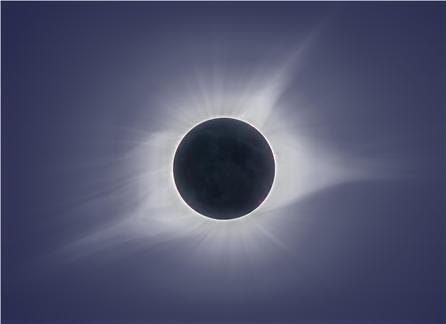
Solar corona observed from the ground during a total solar eclipse in the US in August 2017[사진 = 천문연구원]
A joint researcher at the Korea Astronomical Research Institute and NASA (hereinafter referred to as NASA) found the temperature and speed of electrons in the solar corona region. The solar corona is the part that makes up the outermost layer of the solar atmosphere, and many phenomena are observed for which no clear cause is yet known.
The Astronomical Research Institute and NASA joint researchers announced on the 18th that in September 2019, the solar corona graph was mounted on a large scientific balloon and successfully observed the corona outside the sun at an altitude of about 40 km above the stratosphere.
The Astronomical Research Institute jointly analyzed the observation data with NASA and announced that the external corona structure had a temperature of about 1 million degrees and a speed of 260 km/sec.
This is the first in the world to simultaneously measure the temperature and speed of electrons in the solar corona region, which means that the core technology of the next-generation corona graph has been successfully verified.
The solar corona is the outermost region of the solar atmosphere. Compared to the photosphere, which is the surface of the sun, the solar corona has a darker brightness and much higher temperature.
The solar corona region expands throughout the solar system through rapid plasma emission called the solar wind, and the high temperature of the corona and the mechanism of acceleration of the rapid solar wind are scientific challenges that have yet to be revealed.

The inner and outer structure of the sun. From the center to the outside, there are nuclei, radiation layers, convection layers, photospheres, chroma layers, and coronas. From the center of the sun to the photosphere, the temperature decreases, but in the corona, the atmospheric layer, it heats up to millions of degrees. The cause of this corona heating phenomenon is still unknown, and the joint researchers are expecting to find a clue through this study. Electrons accelerated in the corona also directly affect the environment around the Earth.[사진 = 천문연구원]
The Corona Graph, developed jointly by the Astronomical Research Institute and NASA, is equipped with a filter of four wavelengths sensitive to changes in temperature and velocity of K-corona electrons, as well as polarization observation, so that the temperature and velocity values can be simultaneously realized as a two-dimensional image. It is the first corona graph designed to be used.
The Astronomical Research Institute is planning to develop a next-generation corona graph with NASA based on the core technology of the corona graph verified this time and install it at the International Space Station (ISS) by 2023.
Dr. Nachimuthuk Gopalswamy, NASA’s head of the research, said, “The solar research is an important research that affects the whole life of mankind, so NASA has been constantly trying to explore the sun.” “The practical achievements of collaborative research that has been steadily exchanging in the solar physics field for the past 10 years.”
“This development of a corona graph for an international space station opens an independent path for low-cost, high-efficiency solar exploration research, and at the same time reveals the secrets of corona heating and solar wind acceleration, the challenges of solar research. It will make a big contribution to solving.”
The results of this study, which simultaneously measured the temperature and velocity distribution of the solar corona, were published in the Solar Physics on January 12, 2021.
©’Five-language global economic newspaper’ Ajou Economy. Prohibition of unauthorized reproduction and redistribution
